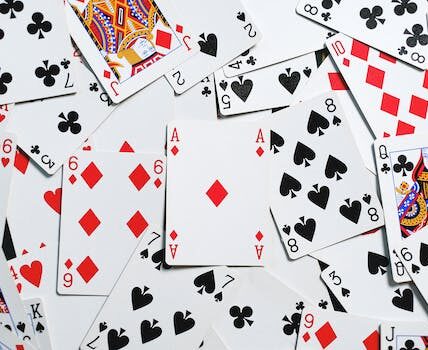“The Art of the Bluff: Mastering the Mind Games to Win Big in Poker” is a guide that delves into the strategic and psychological aspects of bluffing in the game of poker. This guide provides valuable insights and techniques to help players effectively use bluffing as a powerful tool to outwit opponents and secure significant wins. By exploring the intricacies of reading opponents, understanding body language, and manipulating perceptions, this guide aims to equip poker enthusiasts with the skills necessary to become successful bluffers and ultimately, master the mind games of poker.
The Psychology Behind Successful Poker Bluffing Techniques
One of the key elements of successful bluffing is the ability to control your emotions. Poker is a game of strategy, and emotions can cloud your judgment. When bluffing, it is crucial to remain calm and composed, regardless of the cards you hold. Any sign of nervousness or excitement can give away your bluff and allow your opponents to make better decisions. This is why many professional poker players wear sunglasses or hats to hide their facial expressions.
Another important aspect of successful bluffing is the ability to read your opponents’ reactions. When you make a big bet or raise, observe how your opponents respond. Do they seem confident or hesitant? Are they quick to call or do they take their time? These subtle cues can give you valuable information about the strength of their hand. If your opponent seems unsure or hesitant, it may indicate that they have a weak hand and are considering folding. On the other hand, if they seem confident and quick to call, it may indicate that they have a strong hand and are ready to challenge you.
Timing is also crucial when it comes to bluffing. Bluffing too often or at the wrong time can make you predictable and easy to read. It is important to choose your bluffing opportunities wisely. Look for situations where your opponents are likely to be more cautious or vulnerable. For example, bluffing when there are fewer players in the hand or when the pot is large can increase your chances of success. However, be cautious not to bluff too frequently, as your opponents may catch on and start calling your bluffs more often.
Another psychological aspect of successful bluffing is the concept of image. Your image at the poker table can greatly influence how your opponents perceive your actions. If you have been playing conservatively and only showing strong hands, your opponents are more likely to believe your bluffs. On the other hand, if you have been bluffing frequently and getting caught, your opponents may be more inclined to call your bets. It is important to be aware of your image and adjust your bluffing strategy accordingly.
Mastering the Art of Bluffing: Strategies for Fooling Your Opponents in Poker
One strategy for bluffing is to observe your opponents’ betting patterns. If a player consistently bets aggressively when they have a strong hand, you can use this information to your advantage. By mimicking their betting style, you can make your opponents believe that you also have a strong hand. This can force them to fold, allowing you to win the pot without having the best cards.
Another effective bluffing strategy is to use your position at the table to your advantage. In poker, the player who acts last has a significant advantage, as they have more information about their opponents’ actions. By bluffing from a late position, you can put pressure on your opponents and force them to make difficult decisions. This can give you a significant edge in the game.
Timing is also crucial when it comes to bluffing. Bluffing too often can make you predictable and easy to read. On the other hand, never bluffing can make you appear weak and allow your opponents to take advantage of you. The key is to find the right balance and bluff at the opportune moments. This requires careful observation and analysis of the game dynamics.
One important aspect of bluffing is maintaining a consistent image at the table. If you are known for being a tight player who only bets when they have a strong hand, your opponents will be more likely to believe your bluffs. However, if you have a reputation for being loose and aggressive, your bluffs may be met with skepticism. It is important to be aware of your image and adjust your bluffing strategy accordingly.
In addition to these strategies, it is important to remember that bluffing is not a guaranteed winning strategy. It is a high-risk, high-reward tactic that should be used sparingly and with caution. Bluffing requires a deep understanding of the game and your opponents’ tendencies. It is a skill that takes time and practice to master.
How to Read Your Opponents and Execute Effective Bluffs in Poker
One of the first things to understand when it comes to bluffing is the importance of reading your opponents. Pay close attention to their betting patterns, body language, and any other subtle cues that may give away the strength or weakness of their hand. This information can be invaluable when deciding whether or not to bluff.
Timing is everything in poker, and knowing when to execute a bluff is crucial. Bluffing too often or at the wrong time can quickly backfire and cost you chips. On the other hand, a well-timed bluff can be a powerful weapon that can help you build your stack and intimidate your opponents.
When executing a bluff, it is important to consider the table dynamics. Are you playing against tight, conservative players who are unlikely to call a bluff? Or are you up against loose, aggressive players who may be more inclined to call? Adjust your bluffing strategy accordingly to maximize your chances of success.
Another key aspect of bluffing is the ability to control your emotions. It is natural to feel nervous or anxious when attempting a bluff, but it is important to remain calm and composed. Any signs of weakness or hesitation can give your opponents an edge and make it easier for them to see through your bluff.
One effective technique to enhance your bluffing skills is to use a story or narrative to support your bluff. By creating a believable scenario that justifies your actions, you can make it more difficult for your opponents to call your bluff. For example, if you are representing a strong hand, you can act confidently and make consistent bets to convince your opponents that you indeed have a winning hand.
However, it is important to remember that bluffing should not be overused. A successful bluff can be a powerful tool, but if you become too predictable, your opponents will catch on and adjust their strategies accordingly. It is crucial to mix up your play and balance your bluffs with strong hands to keep your opponents guessing.
The Mind Games of Poker: Understanding the Art of Bluffing
To successfully bluff in poker, you need to understand the psychology behind it. Bluffing works because humans are naturally inclined to believe what they see. When you act confidently and make strong bets, your opponents are more likely to believe that you have a strong hand. This is known as the “representational effect,” where your actions represent the strength of your hand.
Timing is crucial when it comes to bluffing. You need to choose the right moment to make your move. Bluffing too often or at the wrong time can make you predictable and easy to read. On the other hand, bluffing too rarely can make your opponents suspicious of your strong hands. It is essential to find the right balance and vary your bluffing frequency to keep your opponents guessing.
Another important aspect of bluffing is reading your opponents. You need to pay close attention to their betting patterns, body language, and reactions. If you notice that a player is hesitant or shows signs of weakness, it may be a good opportunity to bluff. However, if a player is confident and aggressive, it is best to proceed with caution.
In addition to reading your opponents, it is crucial to manage your own image at the poker table. Bluffing works best when you have a tight and aggressive playing style. By playing fewer hands and only entering pots with strong cards, you can build a reputation as a solid player. This image will make your bluffs more believable, as your opponents will be more likely to give you credit for having a strong hand.
However, it is important not to become too predictable. If you only bluff when you have a weak hand, your opponents will catch on and start calling your bluffs more often. To keep your opponents on their toes, you should occasionally bluff with strong hands as well. This move, known as a “semi-bluff,” can be highly effective as it gives you a chance to win the pot immediately or improve your hand on later streets.
Winning Big in Poker: Unleashing the Power of Bluffing Techniques
One of the most important aspects of bluffing is timing. Knowing when to bluff and when to fold is crucial. Bluffing too often can make you predictable and easy to read while bluffing too rarely can make your opponents suspicious when you do bet aggressively. It is important to observe your opponents’ playing styles and adjust your bluffing strategy accordingly. If you are playing against cautious players who only bet when they have a strong hand, bluffing may be more effective. On the other hand, if you are playing against aggressive players who are willing to take risks, bluffing may be riskier.
Another important aspect of bluffing is reading your opponents. Pay attention to their betting patterns, body language, and reactions. Look for signs of weakness or strength. If an opponent suddenly hesitates or shows signs of nervousness, it may indicate that they have a weak hand and are considering folding. Use this information to your advantage and bluff accordingly.
A successful bluff requires confidence. Acting confident can make your opponents doubt their own hand and convince them to fold. Maintain a calm and composed demeanor, even if you are nervous or unsure. Avoid giving away any tells or signs of weakness. Keep your emotions in check and stay focused on the game.
However, bluffing is not without risks. It is a high-risk, high-reward strategy that can backfire if not executed properly. If your bluff is called, you may lose a significant amount of chips. It is important to be prepared for this possibility and have a backup plan in case your bluff fails. This can include having a strong hand to fall back on or knowing when to cut your losses and fold.
In conclusion, bluffing is an essential skill in poker that can lead to big wins. It is a mind game that involves deception, timing, and reading your opponents. Mastering the art of bluffing requires practice, observation, and confidence. However, it is important to remember that bluffing is not foolproof and carries risks. Use bluffing strategically and be prepared for the possibility of failure. With practice and experience, you can become a master of the bluff and increase your chances of winning big in poker.










